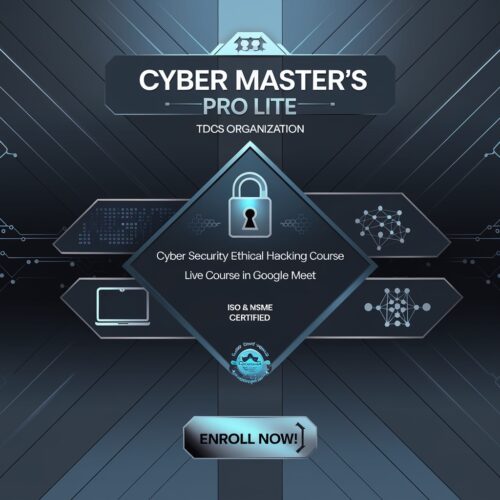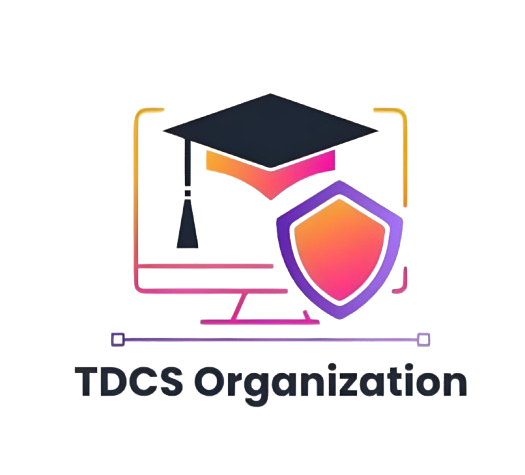Cyber Master’s Pro by TDCS Organization
Welcome to Cyber Master’s Pro, an advanced cybersecurity ethical hacking course offered by TDCS Organization. This comprehensive 4-month live course, conducted via Google Meet, provides in-depth knowledge and hands-on experience in ethical hacking. Here’s a detailed overview of what you will learn and receive:
Table of Contents
1. What is Ethical Hacking?
- Overview: Explore the fundamentals of ethical hacking and its significance in cybersecurity.
2. Role of an Ethical Hacker
- Responsibilities: Understand the daily tasks and responsibilities of ethical hackers.
3. Types of Ethical Hackers
- Roles: Learn about various roles including penetration testers, security analysts, and consultants.
4. Types of Cyber Attacks
- Methods: Gain insight into different cyber attack methods and their potential impacts.
5. Why Choose Ethical Hacking for Your Career?
- Career Benefits: Discover the benefits and growing opportunities in the field of ethical hacking.
6. Roadmap to Becoming an Ethical Hacker
- Guide: Step-by-step guidance on entering and progressing in the cybersecurity profession.
7. Tips to Become an Ethical Hacker
- Advice: Practical tips for succeeding in the ethical hacking career path.
8. Eligibility to Become an Ethical Hacker
- Requirements: Overview of educational and professional requirements for entering the field.
9. Career Opportunities in Ethical Hacking
- Roles: Explore various job roles and career paths within the ethical hacking domain.
10. Demand for Ethical Hackers in 2024
- Trends: Analyze current trends and the growing need for cybersecurity professionals.
Cyber Master’s Pro Curriculum
Introduction
- What is Hacking & Ethical Hacking: Definitions and key differences.
- What is Cyber Security: Core principles and significance.
- Types of Hackers: White-hat, black-hat, and gray-hat hackers.
- What are Hacking Attacks: Common methods and their impacts.
- Types of Malware: Different malware types and their effects.
Hacking Lab Setup
- Installing Virtual Box / VMware: Setting up a virtual environment.
- Installing Kali Linux & Windows OS: Configuration steps.
Networking Fundamentals
- Intro to Networking: Basics and concepts.
- IP Address & MAC Address: Functions and significance.
- TCP & UDP: Protocols and their operations.
- OSI Model: Understanding network layers and their roles.
Android Hacking
- Types of Android Attacks: Overview of attack methods.
- Social Engineering: Techniques for hacking and securing Android devices.
- Android Hacking Tools: Metasploit, Kali NetHunter, and more.
- Securing Android Devices: Best practices and security tools.
System Hacking
- Exploiting Vulnerabilities, Brute-force Attack, Scanning: Techniques for system hacking.
- SQL Injection, DDos, Social Engineering: Specific attack methods.
Wi-Fi Hacking
- Wi-Fi Jamming, Password Cracking, MITM Attack: Techniques and tools.
- Packet Sniffing, MAC Spoofing, WPS Vulnerabilities: Security challenges and solutions.
- Wireshark, Aircrack-ng: Analysis tools for Wi-Fi networks.
Bug Bounty
- Cross-Site Scripting (XSS), SQL Injection, Local File Inclusion (LFI): Identifying and exploiting vulnerabilities.
- Creating and Submitting POC (Proof of Concept): Reporting vulnerabilities effectively.
Information Gathering
- Advanced Search Techniques: Google Dorking, email and DNS footprinting.
- Data Breach Detection: Methods for identifying and managing breaches.
Scanning and Enumeration
- Types of Scanning: Discovering open ports and services.
- Network Enumeration: Enumerating various services and protocols.
Vulnerability Scanning
- Tools & Techniques: Using Nmap, Metasploit, Nessus for vulnerability assessment.
Exploitation (Windows & Linux)
- Windows & Linux Vulnerabilities: Exploiting system weaknesses.
- Metasploit Framework: Utilizing MSF for exploitation.
Post-Exploitation (Windows & Linux)
- Privilege Escalation: Gaining and maintaining access on both Windows and Linux systems.
Man-In-The-Middle Attacks
- ARP & DNS Spoofing: Techniques for intercepting and manipulating communications.
Wireless Sniffing
- Wi-Fi Hacking Techniques: Capturing handshakes, cracking WPA/WPA-2, and exploiting WPS.
- Securing Wireless Networks: Best practices for protecting Wi-Fi networks.
Read Our Full Syllabus Check
Join Cyber Master’s Pro today and elevate your cybersecurity skills with expert-led training, hands-on tools, and comprehensive resources. Enroll now and take the next step in securing the digital world!







Reviews
There are no reviews yet.